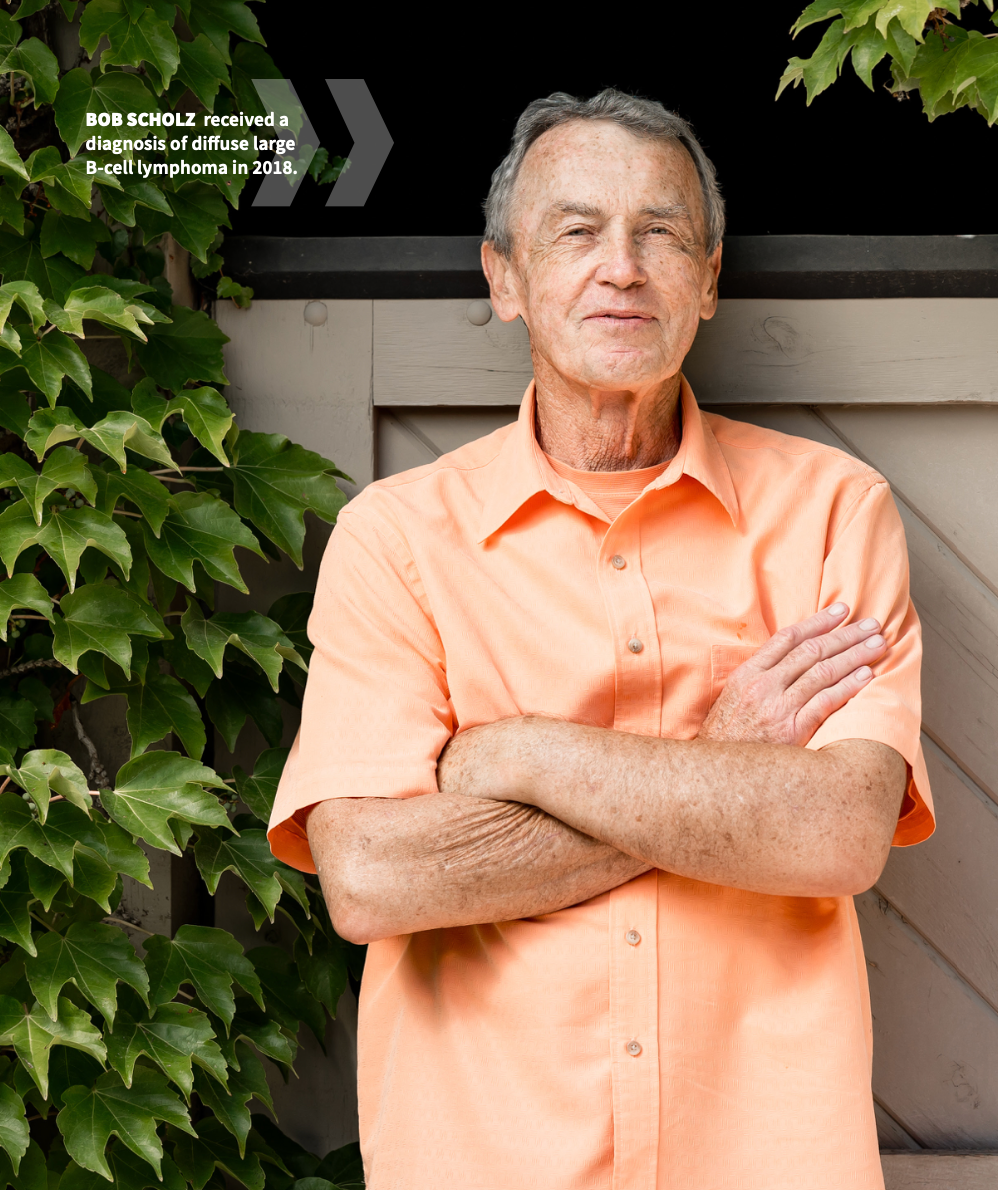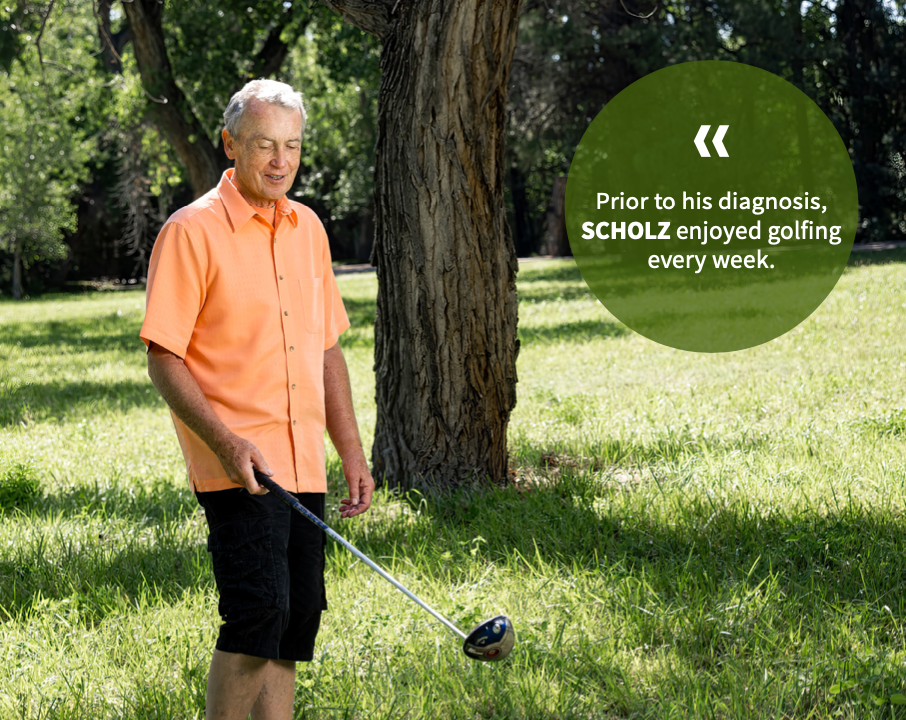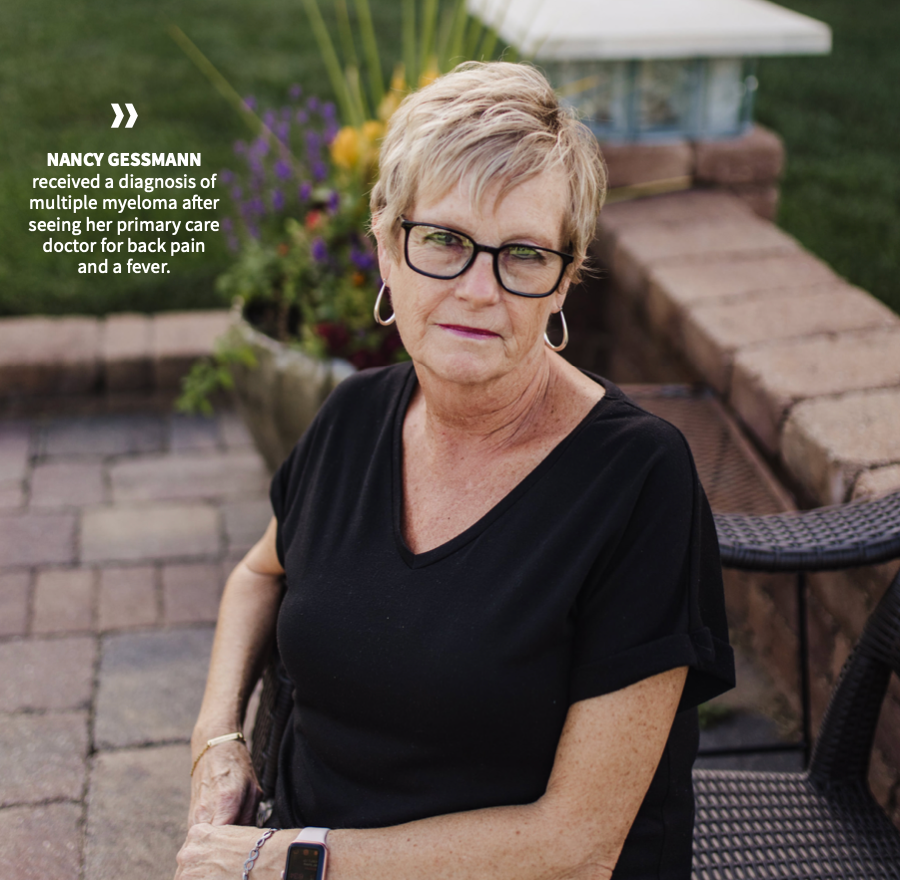Publication
Article
CURE
A New Line of Defense in Blood Cancer: Natural Killer Cell Therapy
Author(s):
Natural killer cell therapy is making strides in blood cancer research, but there’s still much more to learn.
Bob Schulz knew something was wrong when he had a hard time walking up the hill while golfing in December 2018. At 73, he still walked the 18 holes at the Albuquerque, New Mexico, golf course every week. After a chest X-ray, his doctor sent him to the hospital immediately. Two liters of fluid were removed from Scholz’s lungs several times during his four-day hospital stay. Extensive testing revealed malignant pleural effusion, or excess fluid and cancer cells between the tissues separating the lungs from the chest cavity.
Bob Scholz received a diagnosis of diffuse large B-cell lymphoma in 2018.

Scholz sought a second opinion at The University of Texas MD Anderson Cancer Center, in Houston, a 13-hour drive away. There, he received a diagnosis of diffuse large B-cell lymphoma. He and his wife, Cindy, quickly packed up and moved to Houston for six months of R-CHOP chemotherapy, a combination of five drugs infused to kill cancer cells.
After chemotherapy, Scholz thought he was cancer-free, but in late 2020 he lost his voice completely, which sent him back to his oncologist at MD Anderson. A positron emission tomography scan revealed a recurrence of lymphoma in his throat, lung and liver. This time his doctor offered him treatment through a clinical trial for natural killer (NK) cell therapy, a type of infusion therapy that uses the body’s natural killer immune cells or donor NK cells, which are grown into larger quantities and sometimes genetically engineered with additional targeting abilities.
Scholz and his wife, Cindy, moved to Houston so he could receive treatment at The University of Texas MD Anderson Cancer Center.

NK cells are a type of white blood cell in the immune system that can kill cancer and virally infected cells. “They have the innate ability to recognize and attack cells infected with viruses or cancer cells,” says Dr. Sarah Holstein, a multiple myeloma researcher and an associate professor of internal medicine at the University of Nebraska Medical Center in Omaha. However, cancer cells can sometimes evade NK cells’ ability to interact with and kill cancer cells. “The idea behind NK cell therapy is to augment the body’s natural NK cell response and increase it and, hopefully, lead to a more direct cell-killing effect against the cancer cell,” she explains.
Over the past two decades, researchers have studied various ways to do this; for example, by collecting the patient’s NK cells, growing them and then reinfusing them. When using the patient’s cells, it’s called an autologous adoptive transfer. Doctors also are growing cells from donors, called allogeneic adoptive transfer. These cells come from sources such as cell lines, peripheral blood or pluripotent stem cells, which can be found in neonatal foreskin or the umbilical cord, for example. Pluripotent stem cells have the ability to differentiate into many types of mature cells and can develop into NK cells or other needed cell types. “One cell in the lab can produce millions of NK cells,” says Dr. Paolo Strati, an assistant professor in the department of lymphoma and myeloma and the department of translational molecular pathology at MD Anderson Cancer Center. More recently the field has evolved to study genetically engineered NK cells, such as chimeric antigen receptor (CAR)-NK cells, that have the ability to recognize a specific target on the cancer cell.
Prior to his diagnosis, Scholz enjoyed golfing every week.

Following three days of chemotherapy to prepare his immune system, the doctors gave Scholz three infusions of modified NK cells. He finished his treatment in early 2021 and is in remission. “I’m thankful every day about how fortunate I was to go there. I’m thankful to have that kind of a place with treatments with that chance of success,” he says.
A Growing Research Field
Dr. Jeffrey Miller, a professor of medicine in the division of hematology, oncology and transplantation at the University of Minnesota in Minneapolis, has been researching NK cell treatments for more than 25 years. He published a paper in 2005 about administering haploidentical allogeneic NK cells, which were taken from a related donor, to patients. The research showed that the cells can persist and expand in the body and may have a treatment role. His 2014 update, which was published in Blood, included 57 patients with relapsed/refractory acute myeloid leukemia (AML). Researchers used the immunotoxin interleukin (IL)-2 diphtheria toxin fusion to deplete T regulatory cells and thereby help improve NK cell growth rates. In the study, successful NK cell expansion correlated with remission. Patients were given NK cells, cytokines and lymphodepleting therapy.
“There was excitement in the field when we started to see (complete) response rates between 25% and 40% with those updates,” Miller says. “These were patients who progressed after standard therapy and had no other options.” The response allowed some patients to become eligible for allogeneic bone marrow transplants, even when they were not previously eligible.
Today, researchers are trying different trial designs, including an NK multidose strategy from allogeneic cells. “We couldn’t do it when we had to collect cells from individual donors. That only gave us one cell dose,” Miller explains. Allogeneic cells can be expanded much faster, allowing for multiple doses and freezer storage until needed. Some trials are now giving up to six weekly doses of these off-the- shelf cell products, and doctors can infuse the cells in an cell expansion correlated with remission. Patients were given NK cells, cytokines and lymphodepleting therapy.
Nancy Gessmann received a diagnosis of multiple myeloma after seeing her primary care doctor for back pain and a fever.

“There was excitement in the field when we started to see (complete) response rates between 25% and 40% with those updates,” Miller says. “These were patients who progressed after standard therapy and had no other options.” The response allowed some patients to become eligible for allogeneic bone marrow transplants, even when they were not previously eligible.
Today, researchers are trying different trial designs, including an NK multidose strategy from allogeneic cells. “We couldn’t do it when we had to collect cells from individual donors. That only gave us one cell dose,” Miller explains. Allogeneic cells can be expanded much faster, allowing for multiple doses and freezer storage until needed. Some trials are now giving up to six weekly doses of these off-the- shelf cell products, and doctors can infuse the cells in an outpatient clinic instead of during a hospital stay. “The cells are thawed at the bedside and given, and the patients are watched for a few hours for allergic reactions,” Miller says.
The idea behind multidosing is that NK cells don’t persist in the body for as long as T cells, which are used in CAR-T cell therapy. “Think of it as a living drug,” Holstein says. “Once you put them in, those engineered cells persist and continue to fight against the tumor, should there be any remaining tumor cells that flare up again.” Researchers don’t think the NK cells can live as long as T cells, “but we don’t know if they need to live that long. Perhaps they’re super effective early on and we don’t need them to persist,” Holstein says.
In her multiple myeloma research, Holstein led a study that explored the use of off-the-shelf NK cell therapy given shortly after the time of a stem cell transplant. “There are data showing that early recovery of the patient’s own NK cells after a stem cell transplant is associated with improved outcomes. It is hypothesized that this early recovery of NK cells is contributing to the killing off of residual myeloma cells,” she says. By giving multiple doses of off-the-shelf NK cells — or allogeneic cells — researchers are hoping to boost the effect, ensuring that there’s enough time for NK cells to attack any errant myeloma cells during the critical bone marrow recovery time. “At this time, we’re not sure yet if this approach is effective,” Holstein explains.
Although more recent trials are studying multiple dosing, earlier trials such as Holstein’s used one dose. That’s partly because it was difficult to grow enough cells for multiple doses per patient, even using donor cells. Nancy Gessmann was 59 years old when she enrolled in Holstein’s earlier trial in 2017.
She hadn’t heard of multiple myeloma before back problems and a fever sent her to her primary care doctor in Harlan, Iowa, in 2016. After receiving her diagnosis, Gessmann sought treatment an hour away at the University of Nebraska Medical Center, where she received chemotherapy followed by a stem cell transplant in May 2017.
During her 18 days in the hospital for the transplant, she received a single dose of allogeneic NK cells as part of Holstein’s phase 1 study, along with a series of seven cytokine shots (they help stimulate the NK cells) to help the cells expand. “It gave me hope that if there was anything out there that could help me, it was worth trying,” she explains. Aside from feeling tired after the transplant and growth factor shots — which are given to aid the therapy — Gessmann does not think she experienced any side effects from the NK cell infusion.
With the clinical trial, “I had the opportunity to possibly help myself, my family and others. I benefited from clinical research done by others before me with stem cell transplants and chemotherapies. Others helped my treatment plan and made it easier for me. I’m paying it forward,” Gessmann says.
CAR-T Versus NK Cell Therapy
NK cell therapy may have advantages over T cells. Infused CAR-T cells will recognize a cancer cell and attack it. One attack method involves releasing toxins called cytokines, which can lead to a hyperinflammatory state known as cytokine release syndrome (CRS). CRS is caused when a large number of cytokines, proteins made by some immune cells, are quickly released into the blood from immune cells. They can lead to CRS symptoms such as fever, but patients can also experience low blood pressure, low blood oxygen and neuro- toxicities such as difficulty finding words, and severe issues such as a seizure or coma. About 10% of patients receiving CAR-T cell therapy for lymphoma experience severe CRS, and 40% experience severe neurotoxity. “It’s a real problem; hence, we need to look into different treatments,” Strati says.
NK cells potentially can be less toxic than, and as effective as, T-cell therapy. “Treatment for me was extremely easy, and the results were great,” Scholz says. “It wasn’t like serious chemotherapies. I didn’t feel real good for a couple of days, but it was minor. There were no repercussions from treatment.”
The good thing about NK cells compared with T cells, Miller says, is that NK cells don’t induce graft-versus-host disease, which is when infused allogeneic T cells attack the patient’s healthy cells. NK cells are missing the mechanism in T cells that cause it. For NK therapy, “as far as we know, no known neurotoxicity or CRS has been reported in any consistent way today,” Miller says.
The CAR technology also is being used for some NK cell treatments. With CAR, “we engineer NK cells in the lab,” Strati says. “We make them able to recognize specific proteins on top of lymphoma.” Using donor cells, both CAR-T and CAR NK cells can be available to patients more quickly than the patient’s cells.
The first in-human trial in the United States with CAR NK cells was for relapsed/refractory CD19-positive B lymphoid malignancies. The trial encoded NK cells to recognize CD19 and express cytokine IL-15 to improve persistence. Results were published in a 2020 New England Journal of Medicine study, and it continues to receive a lot of attention, Holstein says. The phase 1 and 2 study showed proof of concept that CAR-NK therapy is possible and effective. Of the 11 patients, 8 had a response and 7 had a complete remission.
The Future of NK Cell Therapy
Researchers developed data for NK cells having a similar cancer-killing strategy but different recognition pattern as T cells, leading to “a crazy interest in NK cells,” Miller says. “Until the past decade, people mostly ignored NK cells.”
It’s not just academic labs pursuing them but also cell companies with their own constructs and expansion strategies. The field opened up considerably with the ability to grow billions of cells for off-the-shelf usage in the past 10 years.
Given the multibillion dollar market for anticancer anti- body therapy and the ability of cell therapy companies to genetically manipulate cells with CARs, “I would expect we’re going to see somebody close to clinical approval in the next three to five years,” Miller says.
For more news on cancer updates, research and education, don’t forget to subscribe to CURE®’s newsletters here.





